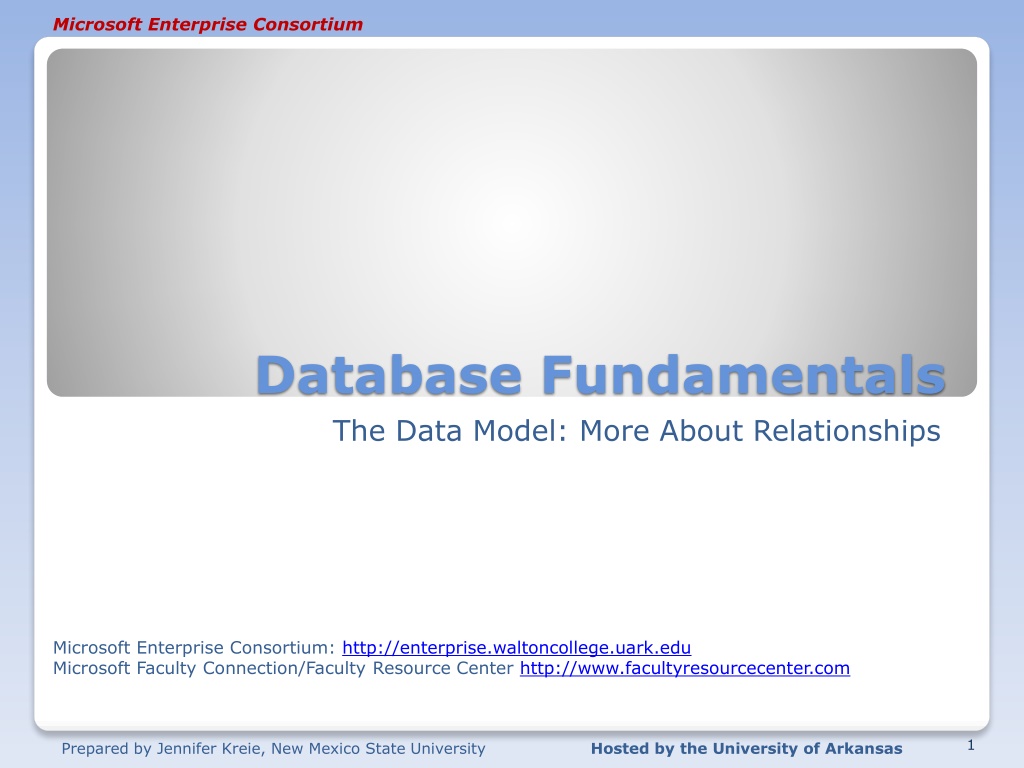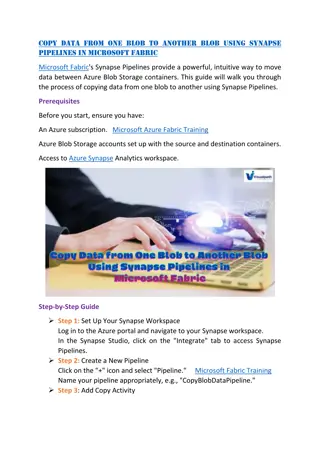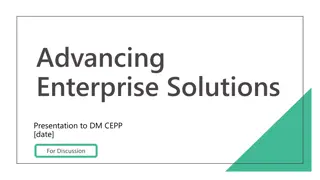Understanding Microsoft Enterprise Consortium Database Relationships
Explore the fundamentals of data models, relationships, and cardinality in the Microsoft Enterprise Consortium Database. Learn about entities, attributes, identifiers, and the different types of relationships like one-to-many, many-to-many, and one-to-one. Gain insights into the degree of relationships including unary relationships, and how to interpret relationship symbols for effective database design.
Download Presentation

Please find below an Image/Link to download the presentation.
The content on the website is provided AS IS for your information and personal use only. It may not be sold, licensed, or shared on other websites without obtaining consent from the author. Download presentation by click this link. If you encounter any issues during the download, it is possible that the publisher has removed the file from their server.
E N D
Presentation Transcript
Microsoft Enterprise Consortium Database Fundamentals The Data Model: More About Relationships Microsoft Enterprise Consortium: http://enterprise.waltoncollege.uark.edu Microsoft Faculty Connection/Faculty Resource Center http://www.facultyresourcecenter.com 1 Prepared by Jennifer Kreie, New Mexico State University Hosted by the University of Arkansas
Microsoft Enterprise Consortium Things you should know This presentation assumes you are already familiar with these terms: Entity and entity type Entity instance Attribute Identifier Multivalued Cardinality 2 Prepared by Jennifer Kreie, New Mexico State University Hosted by the University of Arkansas
Microsoft Enterprise Consortium Relationships and cardinality What do the relationships symbols really mean to us? Here are a few examples of how to read the minimum and maximum symbols. A customer can have a minimum of zero orders. A customer can have a maximum of many orders. An order is for a minimum of one customer. An order is for a maximum of one customer. CUSTOMER ORDER LOCATION EMPLOYEE 3 Prepared by Jennifer Kreie, New Mexico State University Hosted by the University of Arkansas
Microsoft Enterprise Consortium Relationships Based on maximum cardinality, a relationship falls into one of three types: one-to-many many-to-many one-to-one one-to-many many-to-many CUSTOMER ORDER INVENTORY one-to-one LOCATION EMPLOYEE 4 Prepared by Jennifer Kreie, New Mexico State University Hosted by the University of Arkansas
Microsoft Enterprise Consortium Maximum Cardinality Keep in mind that the 3 relationship types (1-to- 1, 1-to-many, and many-to-many) describe the maximum cardinality at both ends of a relationship. It s incorrect to read the minimum and maximum cardinality as one-to-many , for instance. This is NOT one-to-many This is many-to-many. ORDER INVENTORY This is NOT one-to-one This is one-to-many. CUSTOMER ORDER 5 Prepared by Jennifer Kreie, New Mexico State University Hosted by the University of Arkansas
Microsoft Enterprise Consortium Degree of the relationship - Unary The degree of the relationship refers to the number of entities in a single relationship. The options are: unary, binary, ternary. A unary relationship means a entity is related to itself. There is only one entity. Supervises 1. Any one employee Casey Wilson, for example may be supervised by a minimum of zero employees. Any one employee Casey Wilson, for example may be supervised by a maximum of one employee. Any one employee Carla Stevens, for example may supervise a minimum of zero employees. Any one employee Carla Stevens, for example may supervise a maximum of many employees. 2. EMPLOYEE Supervised by 3. 4. 6 Prepared by Jennifer Kreie, New Mexico State University Hosted by the University of Arkansas
Microsoft Enterprise Consortium Degree of the relationship - Binary A binary relationship means two entities are directly related. This is by far the most common one you see in a data model. 1. Any one order order ID # 4528, for example may have a minimum of one inventory items in the order. 2. Any one order order ID # 4528, for example may have a maximum of many inventory items in the order. 3. Any one inventory item Day-Glow Toothpaste, for example may be sold in a minimum of zero orders. 4. Any one inventory item Day-Glow Toothpaste, for example may be sold in a maximum of many orders. sold in ORDER INVENTORY has 7 Prepared by Jennifer Kreie, New Mexico State University Hosted by the University of Arkansas
Microsoft Enterprise Consortium Degree of the relationship - Ternary A ternary relationship means three entities are directly related. However, this three-way relationship between three entities can be decomposed into binary relationships. Therefore, we won t spend more time on this term. 8 Prepared by Jennifer Kreie, New Mexico State University Hosted by the University of Arkansas
Microsoft Enterprise Consortium We ve learned more about relationships In this presentation we ve seen that a relationship is one-to-one or one-to-many or many-to-many. This information has important implications for how the database is actually built. We ve also seen what the degree of the relationship means. How many entities are involved in a direct relationship: unary (1 entity), binary (2 entity), or ternary (3 entity)? Prepared by Jennifer Kreie, New Mexico State University Hosted by the University of Arkansas
Microsoft Enterprise Consortium Resources Microsoft Enterprise Consortium: http://enterprise.waltoncollege.uark.edu/mec.asp The consortium provides teaching material and large databases donated by some major corporations. Microsoft Faculty Connection Faculty Resource Center http://www.facultyresourcecenter.com/ A wide range of teaching resources are available. 10 Prepared by Jennifer Kreie, New Mexico State University Hosted by the University of Arkansas























